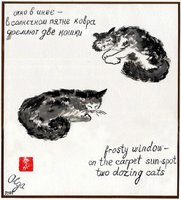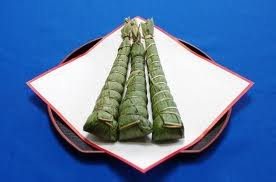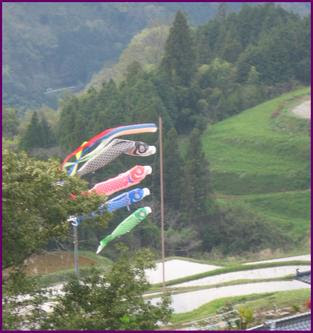:::::::::::::::::::::::::::::::::::::::::::::::::::::::::::::::::::::::::::::::::::::::::::::::::::::
Carneval
***** Location: Worldwide
***** Season: Early Spring (around February)
***** Category: Observance
*****************************
Explanation
shanikusai 謝肉祭 (しゃにくさい) carneval
kaanibaru カーニバル、karunauearu カルナヴァル
Japan has been using the Gregorian calendar since 1874.
Considering the changes of the Japanese calendar
February might be considered "late winter", as far as the climate goes.
. Names of Months and the Haiku Seasons .
:::::::::::::::::::::::::::::::::::::::::::::::::::::::::::::::::::::::::::::::::::::::::::::::::::::
The Latin “Carne Vale” means : Good by to Meat.
From now on the Christian Fasting season starts. It is usually aroud the middle of February.
As a kigo, it will be placed in early Spring, including only the pre-lenten activities.
The Lenten fast is strict in the Greek Orthodox Church. It is preceded by a festive Meat Sunday featuring lamb and other meat dishes, and then a Cheese Sunday, the last day when dairy products are permitted. Lenten fare is restricted to dried beans, lentils, rice, pasta, and vegetables, with fish on special days.
In Greece, a carnival season called apokria precedes the start of Lent. Apokria begins with a feast of roast kid or lamb, followed by two weeks of festivities including parades of masked figures. The third week begins with Tyrini—Cheese Sunday—when cheese, a food forbidden during Lent, is eaten in pies.
The following day is called Clean Monday, and is a national holiday at which many children appear in their Carnival costumes. The pastime of the day is flying special hexagonal kites decorated with geometric designs. Traditionally, all animal foods including fish are forbidden in Lent and some people also eschew oil. Vegetables and legumes are therefore the main Lenten foods of Greece with a little shellfish – permitted because, unlike fin fish, it lacks blood. While many people no longer fast for forty days, most people observe the fast strictly for the two weeks preceding Easter.
http://www.diversityresources.com/intranet/feb_food.htm
xxxxxxxxxxxxxxxxxxxxxxxxxxxxxxxxxxxx
Ed Schwellenbach has the following thoughts:
There are carnivals and then there are carnivals (or maybe you spell it canaval, carnavale, or karneval). In onelook.com, the "quick definitions" for carnival are:
1) noun: a [communal] festival marked by merrymaking and processions. Bracketed word is mine.
2) noun: a traveling show; having sideshows and rides and games of skill etc.
3) noun: a frenetic disorganized (and often comic) disturbance suggestive of a circus or carnival (Example: "The whole occasion had a carnival atmosphere")
It seems to me that:
+ There are hundreds of thousands of carnivals as described in the first two definitions above, e.g., school carnivals, church carnivals, and community carnivals held at any time of the year---
often for fund raising, at least in the USA.
+ There are some famous, local/regional, non-pre-Lenten carnivals with no universality, e.g., Notting Hill Carnival in England, Aalborg Carnival in Denmark, Carnival of Patras in Greece, Samba Parade and Festival in Tokyo, and the Summer Carnival in Rotterdam.
+ There are the "celebrity" pre-Lenten carnivals, e.g., Mardi Gras in New Orleans, Carnaval in Rio de Janeiro, and Carnaval de Quebec in Canada. Perhaps a few others in Cologne, Nice, and Venice, and Mazatlan, Mexico
+ And there are thousands of lesser-known local/regional pre-Lenten carnivals, e.g., Goa Carnival in India, various fastnacht in Germany, including the Swabian-Alemannic Karneval, and Carnaval de Las Palmas in the Canary Islands,
Therefore, the only categories for the database would be the pre- Lenten ones, i.e., the very famous and their many local/regional versions worldwide.
Finally, it seems to me that events like Shrove Tuesday or Fat Tuesday (worldwide), Pancake Day (UK), Paczki Day (Poland) and maybe Herring Day (Poland), and are "related items" in the database---not carnivals in themselves. Although in some places, people part a bit-- -sometimes, quite a bit--- on these days. Carnivals seem to be well- planned community events that include, among other things, parades.
Three good resources that I found are:
http://en.wikipedia.org/wiki/carnival
-A well rounded article with many excellent links and a great picture of Swabian-Alemannic
carnival clowns in Wolfach, Germany.
http://www.carnaval.com/global/in_carnival-links.htm
-A listing of carnivals throughout the world, both pre-Lenten and non-pre-Lenten. Sometimes, this site is very slow to load.
*****************************
Worldwide use
Belgium
Belgium is a great carnival celebrating country... the principal town to look for is Binche, whose carnival has been recognised by UNESCO as a world heritage custom. The food of the day is the fresh orange.
http://www.carnavaldebinche.be/
http://www.visithainaut.be/hr/owa/MtrAttrEven.GetEvenInfo?EVEN_ID=19438&CLANGUE=\EN&RG=H
http://www.visitbelgium.com/bepres08.htm
Isabelle Prondzynski
xxxxxxxxxxxxxxxxxxxxxxxxxxxxx
.. .. .. .. .. .. .. .. Carnival in Rio
Carnival is Rio's main event. It happens at the peak of summer, when Cariocas are at their best. Festivities attract thousands of people from all corners of the world. Carnaval, as spelled in Portuguese, is a 4-day celebration. It starts on Saturday, and ends on Fat Tuesday, or Mardi-Gras.
Dates change every year. Carnival Sunday is seven weeks before Easter Sunday.
The origins of Carnival are unclear, but most agree that it started as a pagan celebration in ancient Rome or Greece. Carnival balls were imported to Rio from Italy in the late nineteenth century, and had their golden era in the 1930 through 50's, with legendary balls at the Copacabana Palace and the Municipal Theater.
The Samba Parade began in the 30's - first timidly at Praça XI, and later on Av. Presidente Vargas. It found a permanent home in 1984 at the Sambodrome, a structure in the downtown area. Today Samba Parade is broadcast to dozens of countries, and all Brazilian states. Many people think of it as the greatest show on earth.
http://www.ipanema.com/carnival/home.htm
xxxxxxxxxxxxxxxxxxxxxxxxxxxxxxxxxxxx
.. .. .. .. .. .. .. .. Carneval in Venice
The mask in the city of Venice has ancient origins and was used for many months of the year. Masks were allowed from the day of Santo Stefano, which marked the start of the Venetian carnival, to midnight of Shrove Tuesday which marked the end. (Naturally, they were forbidden on days of religious festivals).
http://www.carnivalofvenice.com/argomento.asp?cat=13
http://www.virtualtourist.com/m/1ffe4/22643/1/
http://www.venetia.it/s_carn_eng.htm
Here are some of my favorite masks (I was in Venice two years ago and even at no—carneval times the town if full of masks nowadays, mostly worn by tourists.
http://www.venicemaskshop.com/default.htm
http://www.carnivalofvenice.com/area.asp?id=4
http://www.aurumxxl.com/carnival.htm
http://www.exploitz.com/pictures/4920/index.php
.. .. .. .. .. More Links to Masks
http://www.venezia-carnevale.de/karn60/karneval60.html
http://www.venezia-carnevale.de/karn27/karneval27.html
From 2001
http://www.venezia-carnevale.de/karn24/karneval24.html
Click on VENEZIA to see more.
Also click on Martin Hertnagel to enter another set of masks.
http://www.carnevale.de/
oo oo oo oo oo oo
Look at Piazza St. Marco to get in the Venetian Mood.
http://crossspot.net/origasumie/San%20Marco%20and%20Lion.jpg
Venetian Triptych
I was visiting Venice in the end of April when there was Easter Carnival - to celebrate the END of the Fasting period! That was the time I was talking about in my haiku:
Venetian carnival --
masks and pigeons
among the garbage
sinking city...
the winged lion soars
over the pier
crumbling walls
fall into the canal
geranium petals
http://www.trekearth.com/gallery/Europe/Italy/Veneto/Venice/Venezia/photo24698.htm
Olag Hooper
http://thegreenleaf.co.uk/HP/Duets/Olga/00olgahaiku.htm
Some more links
http://www.trekearth.com/gallery/Europe/Italy/Veneto/Venice/Venezia/phooto84655.htm
> http://www.trekearth.com/gallery/Europe/Italy/photo14244.htm
> http://www.exploitz.com/pictures/4177/index.php?pix=7
> http://www.travel-images.com/italy63.jpg
The Venetian Masks of Old
http://foto.lucien.it/carnevale/storia/storia_mask.htm
:::::::::::::::::::::::::::::::::::::::::::::::::::::::::::::::::::::::::::::::::::::::::::::::::::::
Croatia
Fašnik (Carnival, Shrove Tuesday) - Traditional Fašnik
The name Fašnik usually refers to the day before Ash Wednesday, or Shrove Tuesday. On that day, the Evildoer or Fašnik, the one who is to blame for everything bad that happened during the previous year, is burned in effigy, drowned or hung. Before the execution, he stands a trial in which a prosecutor, judge, defense counsel, executioner, and the grieving family take part. The Fašnik dummy is made of straw, cloth, or an old suit.
On Fašnik day, it is customary to cook sauerkraut, žganci (corn mush), beef, to roast a turkey or a goose and to bake krafne (doughnuts). Fašnik is also considered the name-day for men, hence some of them extend good wishes to each other as a joke.
Samobor and Velika Gorica have the longest tradition of organizing Fašnik in Zagreb County, but it is also celebrated in towns and municipalities all over the County.
“Samoborski Fašnik “ (“Samobor Fašnik”) dates back as far as the beginning of the 19th century and its symbol is a masked character “Sraka” (Magpie), which is also the name of the Fašnik newsletter published in Samobor from 1904 till this very day. During Fašnik, various individual and group, children’s and village masks are presented while the streets and squares of the town, restaurants and bars, completely change their outward appearance.
The second oldest Fašnik in Zagreb County is the “Velikogorički Fašnik” (“Velika Gorica Fašnik”) which, according to historical picture postcards of Velika Gorica, is being held since early 20th century. The Fašnik procession usually passes through the town, individual masks and Fašnik groups are presented, and the best are selected in a rich entertainment program.
Look at some nice pictures on these links:
:http://www.tzzz.hr/novo/engleski/edogadjanja/gdogadjanja2b.htm
http://www.tzzz.hr/engleski/SAMOBOR/samoborzanimljivosti1.htm
Samobor Carnival
http://www.phy.hr/~dpaar/samobor/turist.html
>> Faanik-carnival...
>> my tot crying: the straw
>> Evil Prince put on fire
Tomislav Maretic
:::::::::::::::::::::::::::::::::::::::::::::::::::::::::::::::::::::::::::::::::::::::::::::::::::::
Germany
By Erika Schwalm
In Germany we call Carneval "FASCHING" or "FASTNACHT".
The FASCHING starts in Germany on the 11.11. and ends in February with the Pancake Day, Old womens festival, "Altweiberfastnacht"
The principals towns are Koeln, Düsseldorf, Mainz, and other town like Frankfurt ect. BASEL in Switzerland has a famous carneval time.
We have "Kappensitzungen" Partys with speakers about the polical or social situation and dancing girls ,"Kostuemfeste" fancy-dress-party and parad's "Fachingsumzuege"
On Partys we are dressed in funny costumes like "Dracula", "Peter Pan", "Princess", "clowns" Cowboys ect.
the carnevals parad is on the end of the Faschingstime. (February)
On the last day we have Pancake Day "Altweiberfsenacht" .
We let the winter behind and wait for the spring .
The people enjoy themselves before the Great Fast time before Eastertime.
Haiku written by members of the Frankfurt Haikucircle on carneval date 26.2.2003 in the Resatuarant "EAT AND ART" in Frankfurt
(Tr. by Gabi Greve)

Carneval Ikebana by Erika
Einmal im Jahr
hat man gern den Regenguss:
ja Bonbon-Regen
once a year
we enjoy the shower -
the shower of sweets
(thrown from the parade carts on the viewers)
Mieko Schroeder
Weiberfastnacht!
Wie gern werde ich einmal
Krawatten abschneiden
Old Women,s Carnival
I would love to cut
the neckties
Mieko Schroeder
Das Faschingsnase
im Schaufenster Fünf EURO
mir genügt meine.
a fake carnevals nose
in the showroom, five EURO
mine is enough
Erika Schwalm
Üben - üben - üb...
"Jenny, du fette Henni!"
Heute Tanzmarie
practise, practise, pract...
"Jenny, you fat hanny!
Today the Girls Dance Parade
Maria Pohlmann
Rote Stiefelchen
Tressen und Bommeln am Rock
und dann der Applaus
red little boots
cords and beads on the dress
and then the applause
(descriptive of the Carneval Parade)
Maria Pohlmann
Die roten Nasen
am Rande des Faschingszugs
sind nicht von Pappe
red noses
at the end of the Carneval parade
not made of paper
(everyone got a cold, I guess)
Harald Kaiser
Ein verrücktes Jahr!
Ich habe die Narrenkappe
garnicht abgesetzt...
What a crazy year!
I never took off
the Clown,s hat!
Nicole Klutky
Abendrobe?
Oder doch Faschingsjacke?
Je nach Betrachter...
evening dress?
or carneval costume?
as you like it
Nicole Klutky
.................................................................................
Rosenmontag - Rosenmontagszug
Rosenmontag (Rose Monday) is the highlight of the German "Karneval" (carnival), and is on the Shrove Monday before Ash Wednesday, the beginning of Lent.
© More in the WIKIPEDIA !

source with many more : www.spiegel.de
The Rose Monday parades in Cologne, Mainz and Duesseldorf are the highlight of the German street carnival season, in/famous known for their satirical procession floats.
Rose Monday parade
small Sarkozy nestles
between Merkel's breasts
Rose Monday float
sunlit "Merkozy" tattoo
on Merkel's right arm
Chen-ou Liu
February 2012
.............................................................................
Carnival Monday
Leaves a pamphlet behind -
the Roseninsel
Graham England
February 2013

*****************************
Things found on the way
*****************************
HAIKU
Carneval in Venice-
the last mask looks
for the exit
Gabi Greve
http://groups.yahoo.com/group/happyhaiku/message/515
*****************************
Related words
***** Shrove Tuesday, Mardi Gras >
Shrovetide
.. Maselnitsa (Russia)
Shrove Tuesday—Mardi Gras or Fat Tuesday in French—marks the final midwinter fling before Ash Wednesday, the first day of the Lenten fast. Traditionally, believers confessed and were absolved (shrived) of their sins before the fast, then they consumed the last of luxuries such as dairy foods and meat. In England and France people now use milk and eggs to make the traditional pancakes.
In Finland, the Shrove Tuesday specialty is a bun filled with almond paste and whipped cream. In many Roman Catholic countries Shrove Tuesday is the culminating day of Carnival—a word deriving from the Latin words carne vale, "farewell to meat." Carnival parades and balls with masked dancers and costumed figures from popular myth are the annual highlight in Rio de Janeiro, Brazil, Venice, Italy, and New Orleans in the United States as well as many other Mediterranean, South American and Caribbean cities. English pancakes are also a popular dish.
http://www.diversityresources.com/intranet/feb_food.htm
:::::::::::::::::::::::::::::::::::::::::::::::::::::::::::::::::::::::::::::::::::::::::::::::::::::
*****Ash Wednesday. Aschermittwoch
hai no suiyoobi 灰の水曜日 (はいのすいようび)
seikaisai 聖灰祭(せいかいさい)
daisaijibi 大斎始日(だいさいしび)
From the Middle Ages salt cod was a winter staple, especially for Lent and fast days, when meat, eggs, and milk products were both hard to get and forbidden by the Church. But cooks in the Catholic countries of Europe turned hardship to blessing by inventing literally hundreds of ways to cook it. In France there are more recipes for salt cod than for any other single fish. Italy, Spain, Greece, Portugal and the countries of South America and the Caribbean also have a myriad of salt cod dishes, now often served throughout the year.
http://www.diversityresources.com/intranet/feb_food.htm
Next we come to
. Lent (Carême, Fastenzeit) 四旬節 shijunsetsu
:::::::::::::::::::::::::::::::::::::::::::::::::::::::::::::::::::::::::::::::::::::::::::::::::::::
. Christian Celebrations in Japanese Kigo
[ . BACK to WORLDKIGO . TOP . ]
:::::::::::::::::::::::::::::::::::::::::::::::::::::::::::::::::::::::::::::::::::::::::::::::::::::














































